snow chains AUDI Q7 2014 Owner´s Manual
[x] Cancel search | Manufacturer: AUDI, Model Year: 2014, Model line: Q7, Model: AUDI Q7 2014Pages: 340, PDF Size: 85.02 MB
Page 145 of 340
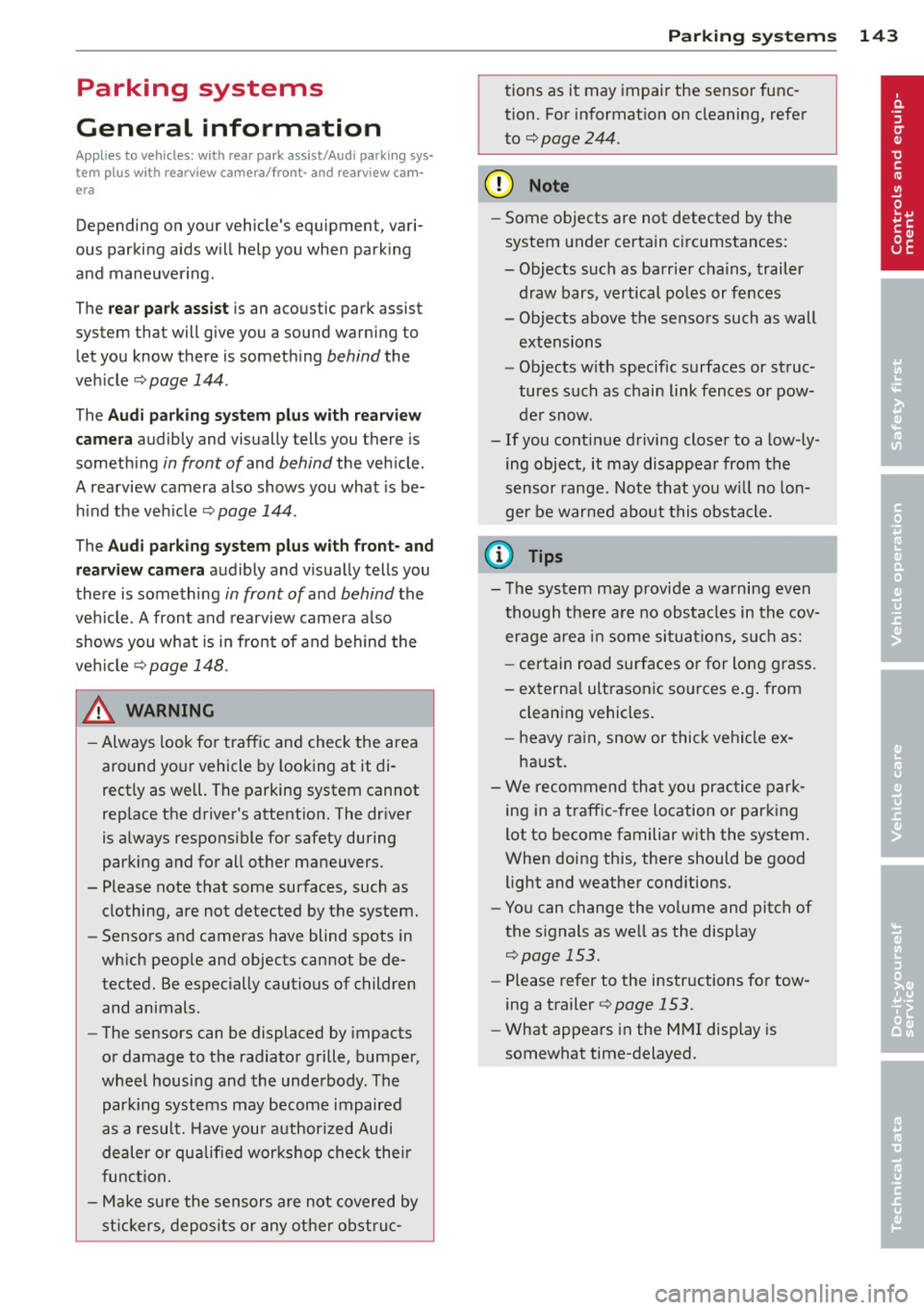
Parking systems
General information
App lies to vehicles: with rea r park assis t/Audi park ing sys
tem plus w ith rearview camera/front -and rearview cam
era
Depending on your vehicle's equipment, vari
ous parking aids will help you when parking
and maneuvering.
The
rear park assist is an acoustic park assist
system that will give you a sound warning to let you know there is something
behind the
veh icle ¢page
144 .
The Audi parking system plus with rearview
camera
audibly and visually tells you there is
something
in front of and behind the vehicle .
A rearview camera also shows you what is be
hind the vehicle ¢ page
144 .
The Audi parking system plus with front- and
rearview camera
audibly and visually tells you
there is something
in front of and behind the
veh icle. A front and rearview camera also
shows you what is in front of and behind the
veh icle¢ page
148 .
& WARNING
-Always look for traffic and check the area
around your vehicle by looking at it di
rect ly as well. The parking system cannot
replace the driver's attention. The driver
is a lways responsible for safety during
park ing and for all other maneuvers.
- Please note that some surfaces, such as clothing, are not detected by the system.
- Sensors and cameras have blind spots in
wh ich people and objects cannot be de
tected. Be especially cautious of children
and animals.
- The sensors can be displaced by impacts
or damage to the radiator grille, bumper,
wheel housing and the underbody . The
park ing systems may become impaired
as a resu lt. Have your authorized Audi
dealer or qualified workshop check their
function.
- Make sure the sensors are not covered by
stickers, deposits or any other obstruc-
Parking systems 143
tions as it may impair the sensor func
tion. For informat ion on cleaning, refer
to
¢ page 244.
([) Note
-Some objects are not detected by the
system under certain circumstances:
- Objects such as barrier chains, trailer
draw bars, vertical poles or fences
- Objects above the sensors such as wall
extensions
- Objects w ith specific surfaces or struc
tures such as chain link fences or pow
der snow.
- If you continue driving closer to a low-ly
ing object, it may disappear from the
sensor range. Note that you w ill no lon
ger be warned about this obstacle.
@ Tips
-The system may provide a warning even
though there are no obstacles in the cov
erage area in some situations, such as:
- certain road surfaces or for long grass.
- externa l ultrasonic sources e .g . from
cleaning vehicles.
- heavy rain, snow or thick vehicle ex
haust.
- We recommend tha t you practice park
ing in a traff ic-free location or parking
lot to become familiar with the system.
When doing this, there should be good
light and weather cond itions.
- You can change the vo lume and pitch of
the s ignals as well as the disp lay
¢page
153.
- Please refer to the instructions for tow
ing a trailer ¢page
153.
-What appears in the MMI display is
somewhat time-delayed.
Page 227 of 340
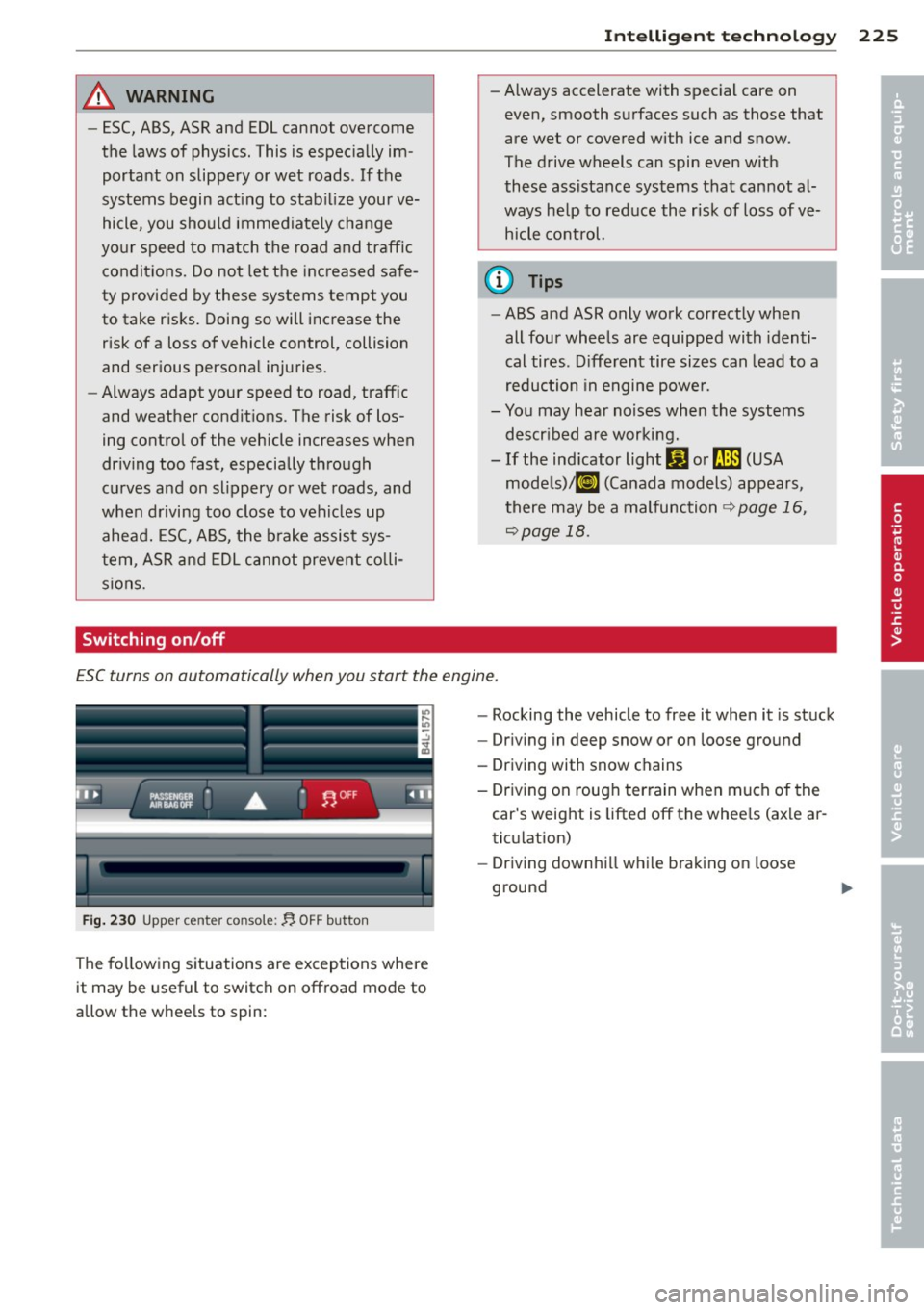
A WARNING 1-=
-ESC, ABS, ASR and EDL cannot overcome
the laws of physics. This is espec ially im
portant on slippery or wet roads. If the
systems begin act ing to stab ilize your ve
hicle, you should immediately change
your speed to match the road and traffic conditions. Do not let the increased sa fe
ty provided by these systems tempt you
to take r isks. Doing so will increase the
risk of a loss of vehicle control, collision
and ser ious persona l injuries.
- Always adapt your speed to road, traffic
and weather conditions. The risk of los
ing control of the vehicle increases when
dr iv ing too fast, especially through
curves and on slippery or wet roads, and
w hen driving too close to vehicles up
ahead. ESC, ABS, the b rake assist sys
tem, ASR and EDL cannot prevent co lli
sions.
Switching on/off --- -
Intellig ent technolog y 225
-Always accelerate with special care on
even, smooth surfaces such as those that
are wet or covered with ice and snow.
The drive wheels can spin even with
these assistance systems that cannot al
ways he lp to reduce the risk of loss of ve
hicle control.
@ Tips
- ABS and ASR only work correctly when
all four wheels are equipped with identi
cal tires. D iffe rent tire sizes can lead to a
reduction in engine powe r.
- Yo u may hear noises when the systems
descr ibed are working.
- If the ind icator light
DJ or ~ (USA
mode ls)/ ii] (Canada models) appears,
there may be a malfunction~
page 16,
¢page 18.
•
•
ESC turns on automatically when you start the engine .
. ...---------.,
--------------
Fig. 230 Upper center conso le : ~ O FF button
The fo llow ing situations are exceptions where
it may be useful to switch on offroad mode to
allow the whee ls to spin: -
Rocking the vehicle to free it when it is stuck
- Dr iving in deep snow or on loose ground
- Driving with snow chains
- Dr iving on roug h terrain when much of the
car's weight is lifted off the whee ls (ax le ar
ticu lation)
- Dr iving downhi ll wh ile braking on loose
ground
Page 230 of 340
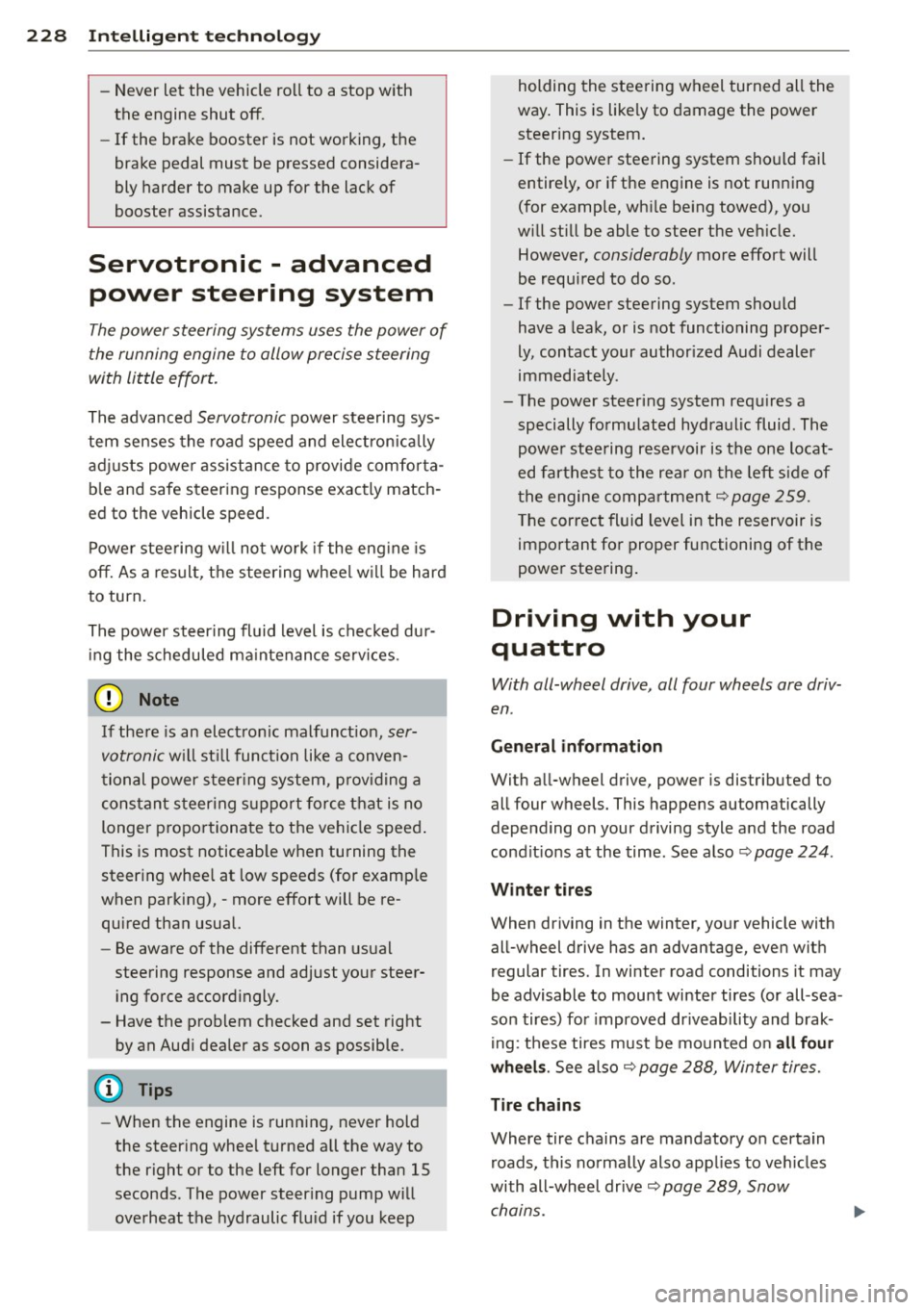
228 Intellig ent technol ogy
- Never let the vehicle ro ll to a stop with
the engine shut off.
- If the brake booster is not working, the
brake pedal must be pressed considera
bly harder to make up for the lack of
booster assistance.
Servotronic - advanced
power steering system
The power steering systems uses the power of
the running engine to allow precise steering
with little effort.
The advanced Servotronic power steering sys
tem senses the road speed and electronically
adjusts powe r assistance to provide comforta
b le and safe steering response exact ly match
ed to the vehicle speed.
Power steering w ill not work if the eng ine is
off. As a result, the steering wheel w ill be hard
to turn.
The power steering fluid level is checked dur
ing the scheduled ma intenance serv ices .
@ Note
If the re is an electronic malfunct ion, ser
votronic
w ill still function like a conven
tional power steer ing system, p roviding a
constant steer ing support force that is no
longer proportionate to the vehicle speed .
This is most noticeab le when turning the
steering whee l at low speeds (for examp le
when parking), -more effort will be re
quired than usual.
- Be aware of the different than usua l
steering response and adjust your steer i ng force accord ingly.
- Have the prob lem checked and set right
by an Aud i dealer as soon as possible.
- When the engine is running , never hold
the steering whee l turned all the way to
the right or to the left for longer than
15
seconds . The power steer ing pump w ill
overheat the hydraulic flu id if you keep holding the steering wheel turned all the
way . This is likely to damage the power
steering system.
- If the powe r stee ring system sho uld fail
entirely, or if the engine is not running
(for example, whi le be ing towed), you
will still be able to steer the ve hicle.
However,
considerably more effort will
be required to do so .
- If the power steering system should
have a leak, or is not functioning proper
ly, contact your author ized Audi dealer
immediately .
- The power steering system requ ires a
specially formulated hyd ra ulic fluid . The
powe r stee ring reservoir is the one locat
ed farthest to the rear on the left s ide of
the engine comp artment r=;,
page 259.
T he correct fluid level in the reservoir is
important for proper functioning of the
power steering .
Driving with your
quattro
With all-wheel drive , all four wheels are driv
en .
Gen eral information
With all-wheel drive, power is distributed to
all four wheels. This happens au toma tically
depending on your driving style and the road
condit ions at the time . See also r=;,
page 224 .
Winter tire s
When driving in the winter, yo ur vehicle with
a ll-wheel drive has an advantage, even wi th
regular tires . In winter road conditions it may
be advisable to mount winter tires (or all -sea
son tires) for improved dr iveability and brak
ing : these tires must be mounted o n
all four
wheels. See also r=;, page 288, Winter tires.
Tire chains
Where tire chains are mandatory on certain
roads, this normally also appl ies to veh icles
with all-wheel driver=;,
page 289, Snow
chains .
Page 291 of 340
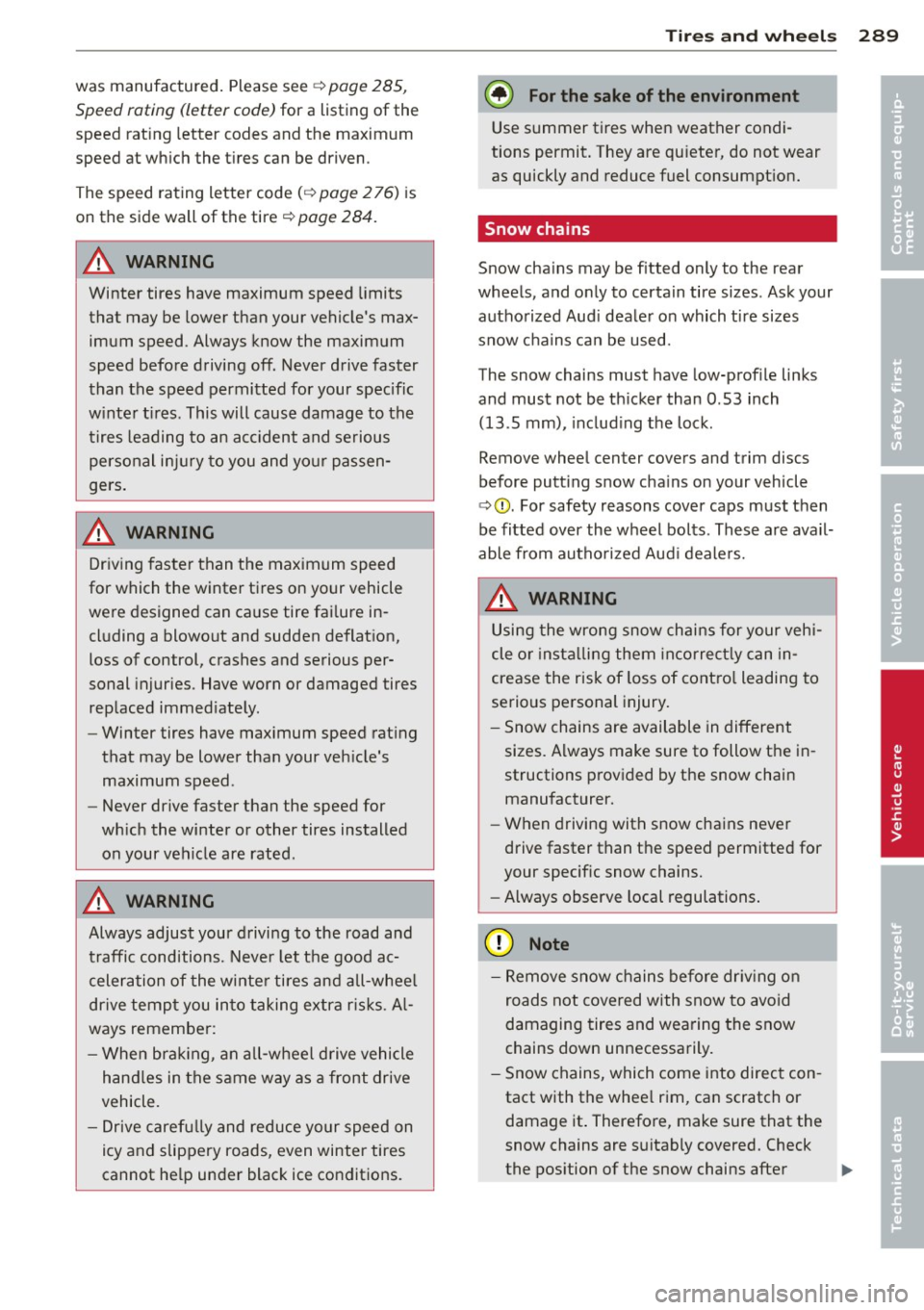
was manufactured. Please see ¢ page 285,
Speed rating (letter code)
for a listing of the
speed rat ing letter codes and the maximum
speed at wh ich the t ires can be driven .
The speed rating letter code (¢
page 2 76) is
on the side wall of the tire
c::> page 284.
A WARNING
Winter tires have maximum speed limits
that may be lower than your vehicle's max
imum speed. Always know the maximum
speed before driving off . Never drive faster
than the speed permitted for your specific
w inte r tires . This will cause damage to the
tires leading to an acc ident and serious
pe rsonal inj ury to you and yo ur passen
gers .
A WARNING
Driving faster than the maximum speed
for which the winter tires on your vehicle
were designed can ca use tire fai lure in
cluding a blowout and sudden deflation,
loss of control, crashes and serious per
sonal injuries . Have worn or damaged tires
replaced immed iately.
- Winter tires have maximum speed rat ing
that may be lower than your veh icle's
maximum speed .
- Never drive faster than the speed for
wh ich the winter or other tires installed
on your vehicle are rated .
A WARNING
Always adjust your driving to the road and
traffic conditions. Never let the good ac
celeration of the winte r tires and all-whee l
drive tempt you into taking extra r is k s . A l
ways remember:
- When bra king, an a ll-wheel drive vehicle
hand les in the same way as a front drive
vehicle.
- Drive carefu lly and reduce your speed on
icy and slippery roads, even winter tires
cannot he lp under black ice conditions.
Tire s an d wheel s 289
'
@) For the sake of the env ironment
Use summer tires when weather condi
tions permit. They are qu ieter, do not wear
as quickly and reduce fuel consumpt ion.
Snow chains
Snow cha ins may be fitted only to the rear
wheels, and only to certain tire sizes . Ask your
authorized Aud i dealer on which tire sizes
snow chains can be used.
The snow chains must have low-prof ile links
and must not be th icker than 0.53 inch
(13.5 mm) , includ ing the lock .
Remove wheel center covers and trim discs
before putt ing snow cha ins on your vehicle
c::> Q) . For safety reasons cover caps must then
be fitted over the wheel bolts. These are ava il
able from autho rized Aud i dealers.
A WARNING
Using the wrong snow chains for your vehi
cle or insta lling them incorrect ly can in
crease the risk of loss of cont ro l leading to
serious personal injury.
- Snow chains are available in different
sizes. Always make sure to follow the in
structions provided by the snow chain
manufacturer.
- When driving with snow chains never
drive faster than the speed permitted for
your specif ic snow chains.
- Always observe local regulations .
(D Note
-Remove snow chains before dr iv ing o n
roads not covered with snow to avoid
damaging tires and wearing the snow
chains down unnecessarily.
- Snow chains, which come into direct con
tact with the wheel rim , can scratch or
damage it . Therefore, make sure that the
snow chains are suitably covered. Check
the pos ition of the snow chains after
•
•
Page 292 of 340

29 0 T ire s and wheel s
driving a few yards and correct if neces
sary. Follow the instructions from the
snow cha in manufacturer when doing so .
- If the Adaptive Air Suspension* should
malfunction, do not mount or use snow
chains because the vehicle will be ex
tremely low. If you do dr ive with snow
chains on while the vehicle is at this lev
el, the snow chains might severely dam
age the wheelhouse and other parts of
the veh icle.
(!) Tips
Where snow cha ins are mandatory oncer
tain roads, this normally also applies to
veh icles with all-whee l dr ive.
Wheel bolts
Wheel bolts must always be tightened to the
correct torque .
The design of wheel bolts is matched to the
factory installed r ims. If different rims are fit
ted, the correct wheel bolts with the r ight
l ength and correctly shaped bolt heads must
be used. This ensures t hat wheels a re fitted
secure ly and that the brake system f unctions
correctly .
I n ce rtain circumstances, you may not use
wheel bolts from a different vehicle -even if it
is the same mode l
<=?page 318.
.&_ WARNING
Improperly tightened o r maintained wheel
bolts can become loose ca using loss of
contro l, a co llision and serious persona l in
jury.
- Always keep the wheel bolts and the
threads in the wheel hubs clean so the
wheel bolts can turn easily and be prop
erly t ightened.
- Never grease or oil the wheel bo lts and
the threads in the wheel hubs. They can
become loose w hile driving if greased or
oiled, even if tightened to the specified
torque. -
On ly use wheel bolts that be long to the
rim being installed .
- Never use different wheels bolts on yo ur
veh icle.
- Always maintain the correct tightening
torque for the whee l bolts to reduce the
risk of a whee l loss. If the tightening tor
que of the wheel bolts is too low, they
can loosen and come out when the vehi
cle is mov ing. If the tightening torque is
too high, the wheel bolts a nd threads
can be damaged and the whee l can be
come loose.
(D Note
The specified torque for the wheel bolts is 120 ft lb ( 160 Nm) with a to le rance of
± 7,4 ft lb( ± 10 Nm) . T orque wheel bolts
diagonally. After changi ng a wheel, the
torque m ust be che cked as soon as possi
ble with a to rque wrenc h - preferab ly by an
a uthorized Audi dea le r or q ualified work
shop.
Low aspect ratio tires
Your Audi is factory-equipped w ith low aspect
ratio tires. These tires have been tho roughly
tested and been se lected specifically for your
model for their superb performance, road fee l
and hand ling under a variety of d riving condi
tions . As k your au thor ized A udi dealer for
more de tails .
T he low aspect ratio of these t ires is ind icated
by a numera l of
55 or l ess in the tire's s ize
designation. The n umeral rep resen ts the ratio
of the tire's s idewa ll height in relation to its
tread width exp ressed in percentage . Conven
t iona l tires have a he ight/width ratio of 60 or
more.
The performan ce of l ow-a spect-r atio tire s is
particularl y sen sitive to imp roper inflation
pre ssure. It is therefo re important that low
a spect ratio tires are inflated to the specified
pressure and th at the inflation pressure is
regularly checked and mainta ined. Tire pres -
s u res should be checked at least onc e a ..,.
Page 295 of 340
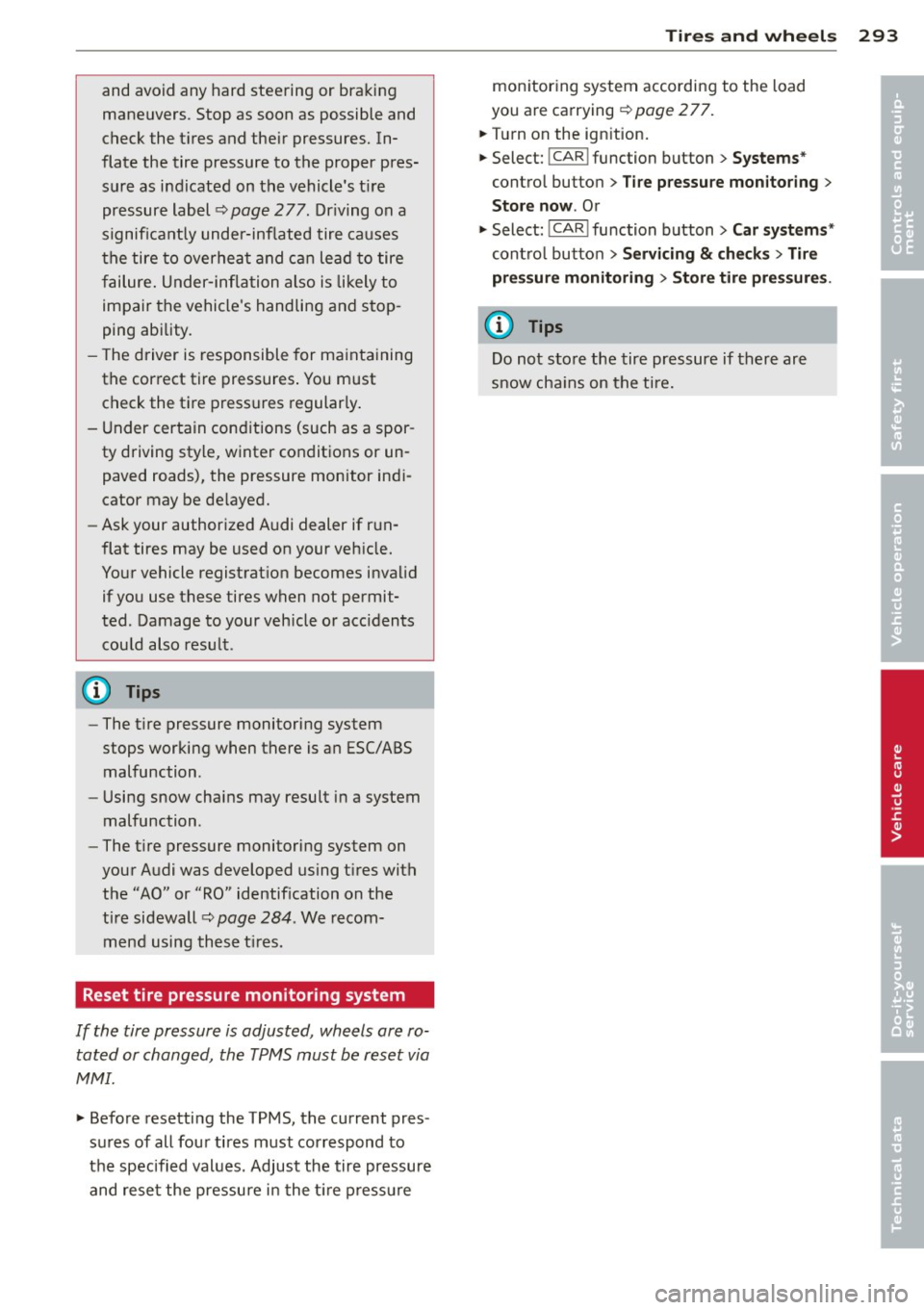
and avoid any hard steering or braking
maneuvers. Stop as soon as possible and
check the tires and their pressures. In·
flate the tire pressure to the proper pres
sure as indicated on the vehicle's tire
pressure label ¢
page 2 77. Driving on a
significantly under-inflated tire causes
the tire to overheat and can lead to tire
failure. Under-inflation also is likely to
impair the vehicle's handling and stop
ping ability.
- The driver is responsible for maintaining
the correct tire pressures. You must
check the tire pressures regularly.
- Under certain conditions (such as a spor
ty driving style, winter conditions or un
paved roads), the pressure monitor indi
cator may be delayed.
- Ask your authorized Audi dealer if run
flat tires may be used on your vehicle.
Your vehicle registration becomes invalid
if you use these tires when not permit
ted. Damage to your vehicle or accidents could also result.
@ Tips
- The tire pressure monitoring system
stops working when there is an ESC/ABS
malfunction.
- Using snow chains may result in a system
malfunction.
- The tire pressure monitoring system on
your Audi was developed using tires with
the "AO" or "RO" identification on the
tire sidewall¢
page 284. We recom
mend using these tires.
Reset tire pressure monitoring system
If the tire pressure is adjusted, wheels are ro tated or changed, the TPMS must be reset via
MMI.
.,. Before resetting the TPMS, the current pres
sures of all four tires must correspond to
the specified values. Adjust the tire pressure and reset the pressure in the tire pressure
Tires and wheels 293
monitoring system according to the load
you are carrying
¢ page 277.
.,. Turn on the ignition.
.,. Select:
!CAR I function button > Systems*
control button > Tire pressure monitoring >
Store now. Or
.,. Select:
!CAR I function button> Car systems*
control button > Servicing & checks > Tire
pressure monitoring
> Store tire pressures .
@ Tips
Do not store the tire pressure if there are
snow chains on the tire.
•
•
Page 334 of 340
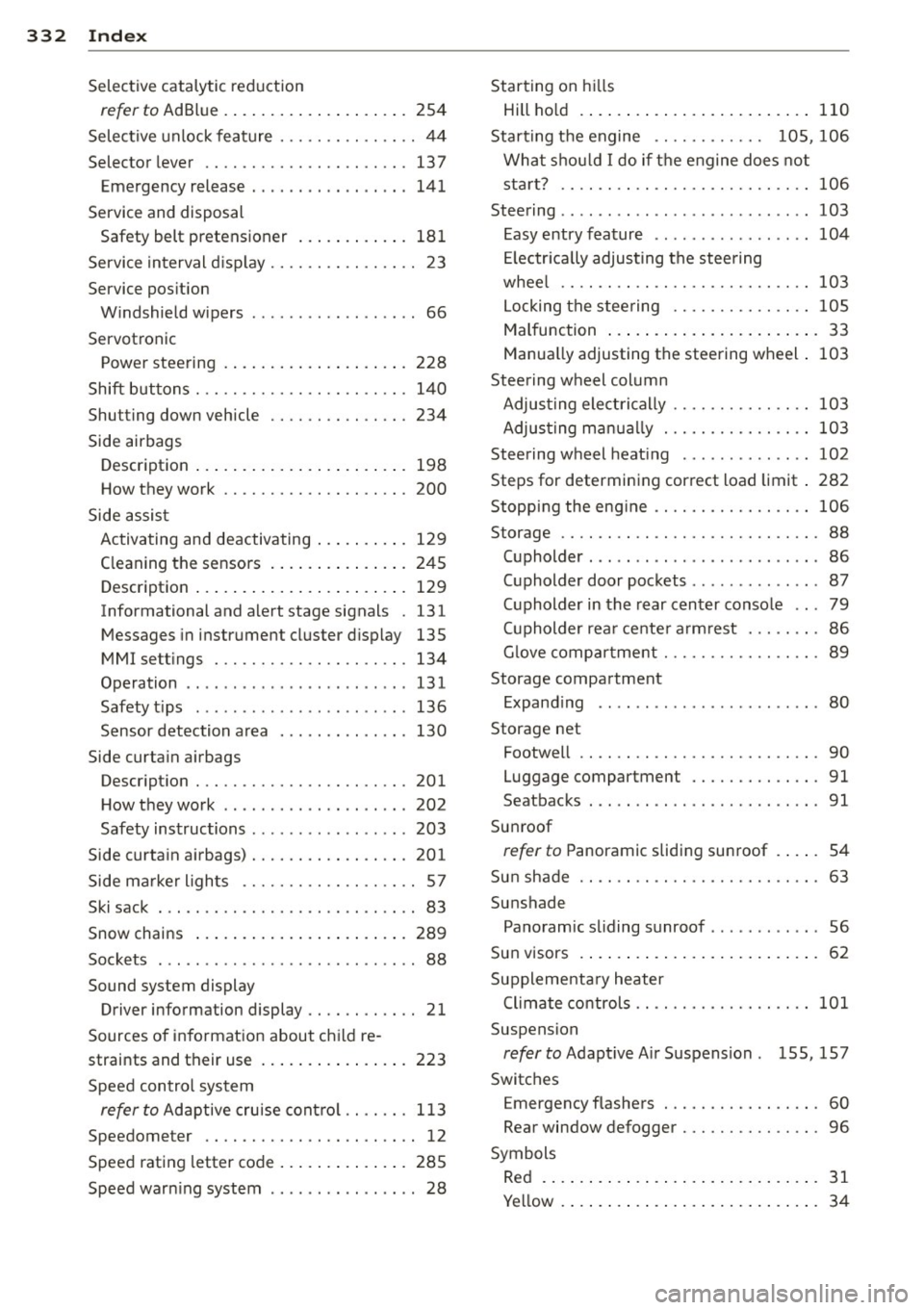
332 Index
Selective catalytic reduction
refer to Ad Blue . ....... ... .. .. .... . 254
Selective unlock feature ..... .. .. .... .. 44
Selector lever . . . . . . . . . . . . . . . . . . . . . . 13 7
Emergency release ................. 141
Service and disposal
Safety belt pretensioner ... .. ... ... . 18 1
Service interval d isp lay ................ 23
Service pos ition
W indshield wipers ............ .. .... 66
Servotronic Power steering .. ...... ... .. .. .... . 228
Shift buttons ... ........... .. .. .... . 140
Shutting down vehicle ............... 234
Side airbags Description .... .. ..... ... .. .. .... . 198
How they work .................... 200
Side assist Activating and deactivating ... .. .. .. . 129
C leaning the sensors .. .. .. .. .. .... . 245
Description .... . ...... ... .. .. .... . 129
Informational and alert stage signals . 131
Messages in instrument cluster d isplay 135
MMI settings .............. .. .... . 134
Operation . . . . . . . . . . . . . . . . . . . . . . . . 131
Safety t ips .... ... .... ... .. .. .. .. . 136
Sensor detection area .............. 130
Side curta in airbags
Descr ip tion ................ .. .... . 201
H ow they work ................ .... 202
Safety instructions ..... ... .. .. .. .. . 203
Side curtain airbags) ........ .. .. .... . 201
Side ma rke r lights ................... 57
Ski sack ... ... ... ...... ..... .. .. .. .. 83
Snow chains .. .. .. ..... ... .. .. .... . 289
Sockets ... .. ................ ... .... 88
Sound system display
Driver information display ...... .... .. 21
Sources of in fo rmat ion about ch ild re-
straints and their use ..... .. .. .. .. .. . 223
Speed control system
refer to Adaptive cruise cont ro l .. .... . 113
Speedometer .............. ..... .. .. 12
Speed rating letter code ... .. .. ... ... . 285
Speed warn ing system .......... .. .... 28 Starting on h
ills
Hill ho ld .. .... .. .. ... ..... ... .. .. 110
Starting the engine . . . . . . . . . . . . 105, 106
What shou ld I do if t he engine does not
sta rt? .... .... .. ............. .... 106
Steering ........... ............... . 103
Easy entry feature ................. 104
El ectr ica lly adjust ing the stee ring
whee l ... ..... .. ............. .... 103
Locking the stee ring ........... .. .. 105
Malfunc tion ..... .. ... ..... ... .. .. . 33
Manua lly adjusting the steering wheel . 103
Stee ring wheel column
Adjusting ele ctrically ........... .. .. 103
Adjus ting ma nually ............ .... 103
Steering wheel heat ing ............. . 102
Steps for determining correct load limit . 282
Stopp ing the eng ine ............. .... 106
Storage .... .... .. ............. .... . 88
(upholder ........ ............... .. 86
(upholder door pockets ............ .. 87
(upholder in the rear center conso le .. . 79
( upholder rea r cente r a rm rest . .. .. .. . 86
G love comp art me nt ............ .. .. . 89
Storage compartment
Expand ing .. .. .................... 80
Storage net Footwell . . . . . . . . . . . . . . . . . . . . . . . . . . 90
Luggage compartment ............. . 91
Seatbacks ... ... . .. .... .... ... .. .. . 91
Su nroof
refer to Panoramic sliding sunroof . ... . 54
Su n shade .. .... .. ............. .... . 63
Sunshade Panoramic sliding sunroof . . . . . . . . . . . . 56
Sun v isors .. .... .. .. ... ..... ... .. .. . 62
Suppleme nta ry heater
Climate controls .. ............. .... 101
Suspension
refer to Adapt ive A ir Suspension . 155, 157
Switches Emergency flashers . . . . . . . . . . . . . . . . . 60
Rear window defogger .......... ..... 96
Symbols Red . ... .. .... .. .. ... ..... ... .. .. . 31
Ye llow . ... .... .. .. .... .... ... .. .. . 34